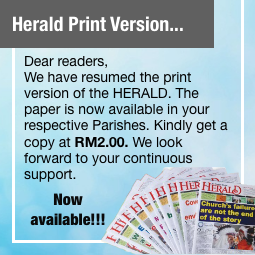Brewing Faith … Letter to the Hebrews
Many scholars describe the Epistle to the Hebrews as a “Literary Riddle” or “The Riddle of the New Testament” in terms of its authorship and epistolary form.
Dec 11, 2021

By Lucille Dass
Many scholars describe the Epistle to the Hebrews as a “Literary Riddle” or “The Riddle of the New Testament” in terms of its authorship and epistolary form. “As to who wrote the epistle, truly only God knows” states Origen. A stylistic appraisal of the epistle and its content suggests it to be part epistolary and part sermonic. Perhaps these intriguing facets of the epistle drew to Hebrews the 118 eager beavers – 51 coming from parishes outside of Penang – to find out what was brewing!
The Cathedral of the Holy Spirit Parish Formation Team, in consultation with parish priest Fr Joachim Robert, chose to run this recently concluded eight-part video faith boosting programme by Dr Andrew Swafford and Jeff Cavins. The video viewing was followed by facilitator-led small group discussions. Why Hebrews? Bernard Capel, the coordinator, felt that it would enhance participants’ understanding of Christ as Priest-King. The timing was also providential as the second readings for Sunday Masses in OctNov were mainly sourced from Hebrews. This, he said, “would, in a way, help to prepare the hearts of the participants for the liturgical feast of Christ the King.”
Fr Joachim, having discerned how Hebrews glistened with pithy aphorisms, set all groups an engaging project from the outset: Each group was to select a Hebrews verse that resonated with their group and write and illustrate a short commentary on it. These creative projects now adorn the CHS Facebook and Instagram pages.
Hebrews is considered complex and the most theological of the New Testament books, as some participants acknowledged. The opening verses set the tone for the two major themes: the supremacy of Christ and perseverance in Christ in the face of persecution. To strengthen your faith – the mainstay of Hebrews – jump to chapter 11, famously called the “Hall of Faith”, for a refreshing throwback to Old Testament (OT) faith heroes, then advance to chapter 12 for “the pioneer and perfecter of our faith” (v.2), JESUS! Keep handy multiple bookmarks as you peruse this epistle (with CCC by your side!) because you have to keep turning the pages from the Old Testament to the New to grasp the full meaning for an “Ah ha!” moment. This is how some of the participants discovered and understood the tie-ups, parallels, typologies, and foreshadowing … thereby giving credence to St Augustine’s remarkable assertion, “The new is in the old concealed, the old is in the new revealed.”
The feedback also proved Dr Swafford and Jeff Cavins right! They asserted that after Hebrews, “Mass will never be the same again!” Participants agreed that they now attach additional significance, value and reverence when receiving the “Medicine of immortality” – the Holy Eucharist; and that they are now more attentive during Mass.
Many felt enriched through their small group discussions, particularly in understanding certain biblical expressions, argumentations and concepts when seen in light of the link between OT and NT contexts, and related cross-references.
Participants drew much wealth from Hebrews – a master faithbrewing infusion for Christian living. It ended with an exhortation to live well, and to be mindful of our attitudes and actions (13:1-6). It leaves us with an entire chapter of counsels of encouragement and hope that also resonate with the season of Advent. Consistent with how the epistle begins and carries on, it similarly ends with the superiority and constancy of Christ.
A takeaway: Vatican 11 assures us in The Church in the Modern World that “There are many realities which do not change and which have their ultimate foundation in Christ, who ‘is the same yesterday and today and forever’” (Heb.13:8).







Total Comments:0